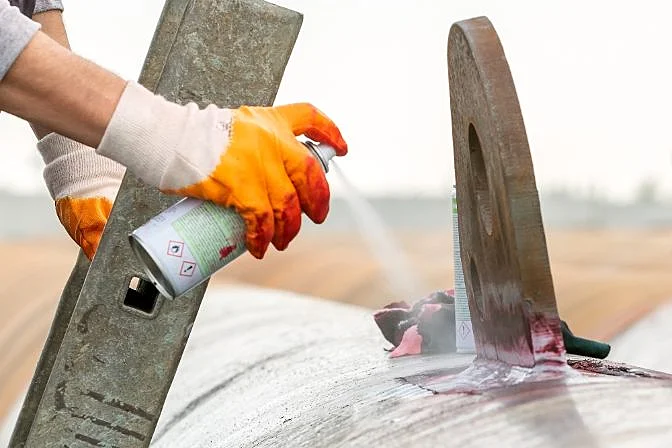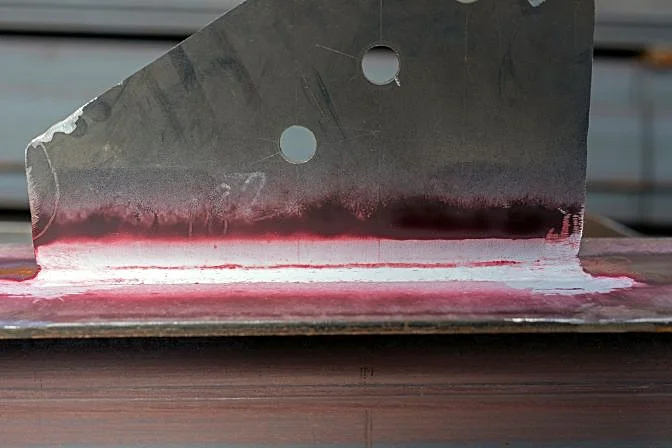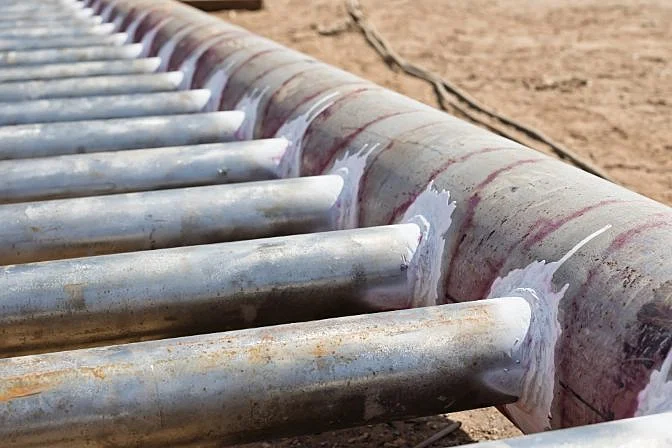What Is Dye Penetrant Testing?
Dye penetrant testing is a widely used non-destructive inspection technique that helps inspectors identify surface flaws in materials. It involves applying a special dye to the surface of an object, allowing it to seep into any cracks or discontinuities. After a certain period, the excess dye is removed, and a developer is applied to make the defects visible.
This method is also commonly referred to as liquid penetrant testing, liquid dye penetrant testing, or simply penetrant testing. In this guide, we will use the terms "dye penetrant" and "liquid dye penetrant" interchangeably, as they are often used in the same context.
Dye penetrant testing is part of the broader category of non-destructive testing (NDT), which allows for the examination of materials without causing damage. This makes it particularly useful in industries where preserving the integrity of the material is essential.
[Dye penetrant NDT is just one of the many non-destructive testing (NDT) methods used by inspectors. For more information on NDT, check out this comprehensive guide.]

What Is Dye Penetrant Testing?
Dye penetrant testing is a practical and cost-effective way to detect surface flaws such as cracks, porosity, and leaks in various materials. The process relies on capillary action, where the dye penetrates into the surface defects and becomes visible after the application of a developer.
It's commonly used on non-porous materials like ceramics, plastics, and metals. Industries such as aerospace, automotive, and manufacturing rely on this method to ensure the quality and safety of their components.
Some common applications include inspecting welds, castings, forgings, plates, bars, and pipes. Inspectors look for issues like fractures, incomplete fusion, hairline cracks, and other surface imperfections that could compromise structural integrity.
The origins of dye penetrant testing can be traced back to the early 20th century when it was first used in the railroad industry. Initially, it involved the oil and whiting method, where chalk was used to absorb oil from cracks. Over time, the process evolved with the introduction of colored dyes to improve visibility.

The Pros and Cons of Dye Penetrant Examination
Dye penetrant testing is popular among inspectors due to its affordability and ease of use. However, it has both advantages and limitations that should be considered before implementation.
Pros
- Easy to perform even on complex shapes and surfaces
- Cost-effective—no expensive equipment required
- Quick to apply over large areas
- Visual detection of defects on the surface
- Flexible for use on a wide range of materials
Cons
- Limited to surface-breaking defects only
- Not suitable for porous materials
- Requires clean, unobstructed surfaces
- Needs direct access to the material
- Multiple steps involved, each affecting results
- Chemicals are used, requiring proper handling and disposal
Procedure for a Dye Penetrant Test
Conducting a dye penetrant test typically follows these six steps:
1. Clean the Surface
The first step is to thoroughly clean the surface to remove dirt, oil, or any contaminants that might interfere with the test. Methods can range from wiping with a cloth to using solvents or even grinding, depending on the situation.
2. Apply the Dye Penetrant
A specialized penetrant is applied to the surface, either by spraying or brushing. The penetrant is left to dwell for a specific time, usually between 5 to 20 minutes, as indicated on the product label.
3. Remove Excess Penetrant
After the dwell time, excess penetrant is wiped off using a dry cloth. A remover may also be used to further clean the surface.
4. Apply Developer
A white developer is then applied to draw the penetrant from the cracks and make them visible. This step enhances contrast and improves defect visibility.
5. Inspection
Inspectors examine the surface under normal or UV light, depending on whether the penetrant is visible or fluorescent. Defects become apparent, and inspectors can assess their size and location.
6. Clean the Surface
Finally, the surface is cleaned to restore it to its original condition, especially if the material will be used again or returned to service.

Choosing Penetrants, Removers, and Developers
Inspectors have several options when selecting the right combination of penetrants, removers, and developers. These choices depend on the type of material, the environment, and the specific needs of the inspection.
Penetrant Types
- Color Contrast
- Fluorescent
- Combination
Remover Types
- Solvent-based
- Post-emulsifiable
- Water-soluble
- Water-suspendable
Developer Types
- Dry powder
- Aqueous
- Non-aqueous
Each choice has its own benefits and is suited to different scenarios. Selecting the right combination ensures accurate and reliable results.
Dye Penetrant Standards and Codes
Dye penetrant testing is not only used for general inspections but also for code-compliant procedures. In such cases, strict adherence to established standards is required to ensure consistency and reliability.
Some of the most commonly referenced standards include:
ASTM (American Society for Testing and Materials)
- ASTM E 165: Standard Practice for Liquid Penetrant Examination
- ASTM E 1417: Standard Practice for Liquid Penetrant Testing
- ASME BPVC, Section V, Article 6: Liquid Penetrant Examination
ISO (International Organization for Standardization)
- ISO 3452-1: Non-destructive testing - Penetrant testing - Part 1: General principles
- ISO 3452-2: Non-destructive testing - Penetrant testing - Part 2: Testing of penetrant materials
- ISO 3452-3: Non-destructive testing - Penetrant testing - Part 3: Reference test blocks
CEN (European Committee for Standardization)
- EN 1371-1: Founding - Liquid penetrant inspection - Part 1: Sand, gravity die and low pressure die castings
- EN 10228-2: Non-destructive testing of steel forgings - Part 2: Penetrant testing
- EN 10246-11: Non-destructive testing of steel tubes - Part 11: Liquid penetrant testing of seamless and welded steel tubes
For more details on these standards, you can visit the official websites of the respective organizations. Understanding and following these guidelines ensures that your dye penetrant testing is accurate, reliable, and compliant with industry requirements.
Embark on a vibrant aquatic adventure with our inflatable ride-on-a playful and eye-catching addition to your poolside escapades. This buoyant and colorful ride on Pool Floats is designed for those who seek excitement and joy in every splash.
Crafted with quality materials, our inflatable ride-on ensures a sturdy and comfortable experience as you explore the pool. The vibrant design adds a pop of color to the water, creating an inviting and lively atmosphere for all ages. The ride-on's construction strikes the perfect balance between softness and durability, ensuring hours of fun without compromising on resilience.
Let your imagination run wild as you navigate the pool on our vibrant ride-on. The thoughtful design includes sturdy handles for a secure grip, allowing riders of all ages to confidently steer through the water. Whether you're hosting a pool party or enjoying a solo dip, this inflatable ride-on is your ticket to endless aquatic excitement.
Easy to inflate and deflate, our inflatable ride on toy is a convenient companion for impromptu pool adventures. The lightweight and portable nature of the inflatable make it ideal for beach trips, pool parties, or simply lounging under the sun. Unleash the vibrant spirit of summer with this engaging and playful ride-on, ensuring that every pool session becomes a thrilling exploration.
Transform your pool into a lively playground with our vibrant ride on float. Dive into the refreshing waters, create lasting memories, and let the colors of fun and excitement infuse your aquatic experiences. Elevate your poolside adventures with this cheerful and buoyant ride-on, inviting everyone to explore the pool in style.
Float Rider,Inflatable Rider,Pool Float Unicorn,Inflatable Flamingo
Lixin Outdoor Product Co., Ltd , https://www.pdinflatable.com